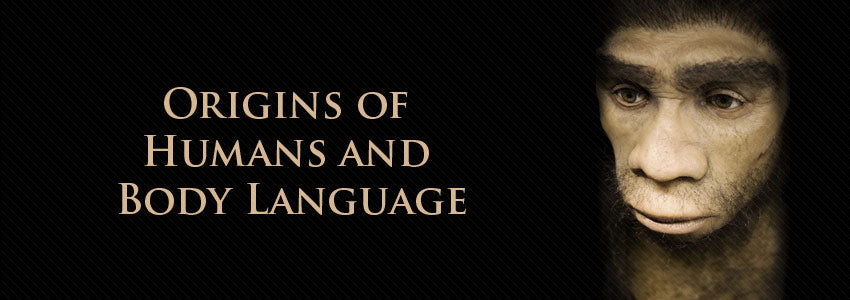
Origins of Humans and Body Language
The use of body language goes back to prehistory and indeed pre-language times. After all, when we didn’t know how to communicate verbally, all we had was to communicate with non-verbal signals.
Some signals are universal. Everyone around the world understands that smiling suggests happiness, satisfaction or when you want to show that you don’t mean any harm. Crying is taken for sadness or pain. How come these facial expressions are universal? How come we can understand each other through body language? There are indeed some cultural differences, but there are also many similarities. Despite various racial differences in body shape and colour around the world, there is still a lot of similarity among humans which directly leads to comparable uses for body language. Why are we the same? The answer lies in significant breakthroughs and research carried out in the last decade, in particular in the field of genetics (Wade 2007). Let’s go back in time and see when it has all begun.
Around 5 million years ago, a chimplike population of about 100,000 was living in equatorial Africa. The forests in Africa were shrinking. It was a hot and dry climate. Foraging through the canopy of trees no longer proved to be adequate and they had to adapt to find more food and increase their chances of survival. The first evidence of walking apes is around 4.4 million years ago. With the ability to walk, the Australopithecines could look for more variety of food and cover a larger distance. This gave them an evolutionary advantage over others. However, the need to cover a larger area increased the complexity of their environment as it was no longer only limited to a canopy of trees.
As they were strongly social, to manage the complexity of this new environment, Australopithecines had to work in groups. This meant that they needed to parse social interactions, understand who is a friend and who is a foe and decide who belongs to their group and who doesn’t. This put a huge demand on their mental processing power; i.e. they needed a stronger brain to get the politics of their interactions right.
This mental demand led to an increase in their brain size from about 400-500cc (similar to modern ape) to 600-800cc around 2.5 million years ago. In other words, evolutionary speaking, those who had a smaller brain could not survive as well as those who had a bigger one and were gradually replaced. At this point the Homo habilis had emerged. However, the increased brain size required more energy. Homo habilis began to eat meat and used stone tools to do so. At 2.5 million years ago, they still had their fur. As part of socialisation, they spent about 20% of their time checking each other’s fur. This limited their group size to about 50.

The trend continued and by 1.7 million years ago several changes started to take place. The brain size had steadily increased to about 800cc. Because of the increased brain size, the temperature of the brain was also increased and needed a stronger thermal regulation. This evolutionary pressure eventually led to losing hair and fur. At the same time, the pressure on regulating brain temperature led to the development of sweat glands to further cool the body and the brain through perspiration. The skin darkened to withstand the UV radiation since the fur could no longer protect it. This was the emergence of Homo ergaster. At this point there was also a social shift towards the male-female bond. They still lived in groups of about 50. All interpersonal communication among the group took place by body language. There are still no words or a language to speak with.
Fast forward to about a million years ago and we have the emergence of Homo erectus. This is a monumental time in history as it marks the first spread out of Africa. By this time, there was a much stronger male-female bond.
By 500,000 years ago, a second migration to Europe by Homo Heidelbergensis led to Neanderthals who emerged about 400,000 years ago. Interestingly, Neanderthals had a bigger brain than modern humans and were also more muscular so it seems that they must have had a very good chance to compete and remain superior to all other humanoids. However, it seems that they failed to develop and evolve one fundamental skill and behaviour which cost them dearly as you will see shortly.
By about 200,000 years ago, humans had evolved to a stage that they were anatomically modern and the brain size had reached 1400cc, equivalent to a modern human’s brain today. This was the emergence of Homo sapiens, our ancestors.
After several environmental cooling and warming periods, some as a result of the disastrous Toba supervolcano which might have led to a human population bottleneck, Homo sapiens evolved to behaviourally modern humans around 50,000 years ago. This is another monumental moment in history as it seems that several major developments took place. A major turning point here was the birth of language.
One of the critical problems with the development of language is reliability. Suppose a primate makes a sound as a signal. How can other primates rely on this signal and trust it? How do they know it is not faked? As the saying is “words are cheap”. Primates don’t adhere to any sense of morality so if they can fake a signal for their own benefit, they will. This is why we developed emotionally expressive signals that are difficult to fake.
The best defence against deception by a fake verbal signal is to ignore all verbal signals altogether. Unfortunately this blocks any progress towards developing a verbal language.
So how did humans end up with a language? To be able to communicate without the danger of being deceived, they required a society that had a moral regulation. In other words, language and rituals co-evolved together. In order to see if a person was honest or not, the society could rely on the person’s belief and adherence to a ritual; this was the birth of religion.
Humans could now use body language as well as verbal signals to communicate with each other. In addition, this was also the first time they could say something verbally and something else non-verbally. To counteract the devastating effect of lies on group cohesion, humans developed rituals and religion. Those who believed in the religion were by definition more trustable and as a result a group of Homo sapiens who believed in a religion could maintain their cohesion more strongly than other groups and so could compete better for resources to gain power and eventually to reproduce and expand. This also led to the development of many superstitions. Those who believed in the same superstitions were more likely to be part of the same group and belief system.
Because of language, social grooming could now be conducted verbally and much more quickly. Humans no longer needed to spend 20% of their time checking fur! This meant an increase in group sizes from about 50 to 150. The vocal grooming eventually led to what we now call gossip.
It was at this point, about 50,000 years ago, that a small group of Homo sapiens, with their own specific language and rituals, left Africa to spread across Asia and Europe which by now was occupied by the decedents of earlier human migrations including Neanderthals.
Current genetic evidence analysed in recent years, especially after the completion of the human genome project in 2004, shows that all modern humans who live today have descended from a small group of humans, perhaps only as much as 5000 couples, who lived in East Africa around 50,000 years ago.
Once out of Africa, Homo sapiens spread quickly to all over the world and started competing with all other members of the genus homo who had occupied parts of the world earlier. We also have the first signs of art and systematic fishing at this point. By 46,000 years ago, Homo sapiens had reached Australia. By 40,000 years ago there were art in caves of Europe. It seems, that armed with language, Homo sapiens were unstoppable and superior to all others, even those with bigger brains and muscles such as Neanderthals. By 30,000 years ago, the physically superior Neanderthals were extinct. By 20,000 years ago humans invented the bow. By 15,000 years ago there were settlements in Siberia and then in the Middle East as up to now in history humans have always lived as a nomadic tribe. By 14,500 years ago humans had reached Americas. By this point all other members of the genus Homo were extinct except Homo sapiens.

By 10,000 years ago we have agriculture, followed by domestication of sheep, goat, modern wheat and horse. By 6000 years ago the first cities were created in Mesopotamia, present Middle East.
The first writing system was introduced in Mesotopamia around 5600 years ago which marks the beginning of historic records. After this, humans embarked on a an incredibly explosive technological and social progress, starting from the invention of the wheel 5400 years ago, Egyptian dynasties at 5100, the iron age from 3200 years ago, discovery of Zero as a number 1500 years ago, discovery of gunpowder 1000 years ago, fuel-driven technologies 200 years ago and eventually to birth of computation and artificial intelligence 50 years ago. This is yet to be followed by the emergence of computational singularity when humans invent a computational entity which is more intelligent than them.
The story of the origin of humans, their language, their customs and how they spread through Earth is both fascinating and educational. The subject is constantly evolving as it relies on research carried out in multitude of fields such as archaeology, geology, biology, ethology, anthropology and in particular genetics. There is currently a significant amount of activity in the field of genetics which allows researchers to accurately answer historically hard questions such as do we all come from Africa (yes) or is there an individual woman who lived in the past that everyone who lives today has descended from (Yes, she lived about 150,000 years ago, and there is a man who everyone today is descended from who lived about 50,000 years ago). The beauty of these answers is that they are much more conclusive since they come directly from our genes and are repeatedly verifiable. For details of such developments and the latest research for further study see the references listed below.
The Birth of Body Language as a Scientific Field
Perhaps the greatest discovery is that all humans living today descend from a small group who lived about 50,000 years ago. This shows why we have so much similarity and why, in the context of body language, we can express ourselves similarly to each other from around the world depending on how we feel. This in turn means we now have developed a field called body language which allows us to decode non-verbal signals and cues that are communicated through gestures, posture, facial expression and eye movement. We can then interpret them in addition to what is said verbally. Remember, the field really exists only to allow us to read another person beyond what they actually say or to catch them out if they are lying. Just as the development of language was highly linked to the concept of trust and deception, so is the study of body language. It is ultimately about understanding others better especially when they are not readily verbalising their emotions or thoughts. Equally, it is also about learning how to hide your own emotions and attitudes or fake them to reach a particular objective when interacting with other people.
The field of body language, or more accurately non-verbal communication, consists of three main disciplines; Kinescics, Proxemics and Haptics.
Kinescics
This is the scientific field for interpretation of body language and facial expressions or in general any non-verbal behaviour shown by parts of the body or the whole body. The term was coined by Ray Birdwhistell in 1952, an anthropologist studying how people communicated with each other using non-verbal signals. He made films of people and analysed them to spot patterns of behaviour in various social situations. He believed that all body movements had a meaning and that they could be interpreted much like a language. He even called a basic group of movements as “kineme” much like phoneme in language which represents the smallest abstract speech sound used to construct words. He also asserted that kinemes should always be analysed as clusters to make valid and meaningful conclusions.
Proxemics
This is the scientific field that investigates personal space. The term was coined by Edward T. Hall in 1963 who was a cultural anthropologist. Hall separated his theory to two main categories: personal space and territory. Personal space is about how a person feels and treats the immediate space around him and territory is about how a person claims a particular piece of space and aims to defend it against others. The field is not limited to humans and studies have also been carried out on animals and their attitude towards space and territory. For more details on proxemics, see body language guidelines on personal space, territory and physical contact.
Haptics
This is the study of how humans or animals communicate with each other using touch. For people, communication via touch includes handshakes, hugging, kissing, holding hands, patting on the shoulder and even high-fiving.
Touching is one of the fundamental non-verbal communication mediums. Touch is the earliest sense developed in the foetus. Touch is critical for obtaining information about an environment through sensing surfaces but also is vital for physical intimacy.
Interpretation of touch gestures highly depends on social context, cultural background, the relationship between the people engaged and also the way it takes place. Touching is treated differently by different cultures and even the levels of touching vary. Certain signals such as high-five may only be recognised or practiced in certain cultures, people from other cultures may not know how to engage in it or interpret it.
Body Language and Animal Behaviour
The field of body language is also close to ethology, the study of animal behaviour. The first model ethologist is Charles Darwin whose book “The Expression of the Emotions in Man and Animals” inspired and influenced many researchers in the field. Other researchers such as Julian Huxley extended the field by studying instinctive or natural behaviour in species under specific circumstances. Many non-verbal signals tend to be instinctive, so the field shed light on why we and other close members of the animal kingdom behave in certain similar ways when confronted with certain stimuli. The field provides clues on instincts, behavioural conditioning, cognition and even psychology.
All primates can communicate with each other through facial expressions. Only humans and apes use gestures specifically directed at an individual that they intend to communicate with. As an example, when a chimp stretches his open hand, effectively performing the begging gestures, it could be asking for food or help in a fight. However, studies by Amy Pollick and Frans de Waal on chimps and bonobos show that gestures differ between groups. There is effectively a gesture culture among each group (Pollick and de Waal 2007). They also found that bonobos were much more effective than chimps in communicating using gestures. Bonobos were the only species that could use multimodal communication which is a combination of gestures and facial/vocal signals. The researchers suggest that a vocabulary of gestures could have been the starting point in the evolution of human language since the gestures are disconnected from specific emotions and are easier to control. Gestures in comparison with facial expressions, which can easily give many clues about the emotional state of a person, are also easier to use deceptively. Hence, language could have started from use of gestures.

As you will see in the guides, many of our behaviours have roots in our evolutionary past and so we have come a long way. How would a person express himself when he is defensive? What non-verbal signals are associated with frustration or fear? How would a woman show that she is receptive to a man? Why people choose the same seat they had used before in a classroom even when many others are free? In the guidelines provided here, you will learn about these signals and how you can use them to improve your communication with others, predict their behaviour and avoid being deceived.
References
Dawkins, R. (1976) “Selfish gene”, Oxford University Press.
Dawkins R. (2004) “The Ancestor’s Tale”, Boston: Houghton Mifflin
Endicott, P; Ho, SY; Metspalu, M; Stringer, C (2009) “Evaluating the mitochondrial timescale of human evolution”, Trends Ecol. Evol. (Amst.) 24 (9): 515–21, doi:10.1016/j.tree.2009.04.006, PMID 19682765
Pollick, A. S., de Waal, F. B. M. (2007) “Ape gestures and language evolution”, PNAS 104: 8184-8189
Soares P. et al (2009) “Correcting for Purifying Selection: An Improved Human Mitochondrial Molecular Clock and its Supplemental Data”, The American Journal of Human Genetics, Volume 84, Issue 6, 740-759, 04 June 2009
Wade, N. (2007) “Before the Dawn: Recovering the Lost History of Our Ancestors”, Gerald Duckworth & Co Ltd.

All Articles in the Series
A Comprehensive Guide to Body Language
Origins of Humans and Body Language
How to Read People Using Their Body Language
How to Influence Your Emotional State Using Body Language
Body Language Across Different Cultures
Body Language of Defensive Attitude
Body Language of Good First Impressions
How to Improve Personal Impact
Continue Reading the Body Language Series..
Body Language Guide Article IndexBody Language Training Materials
Body Language Exercises
Explore our collection of free body language training exercises and articles:



Use this body language exercise at the beginning of a session before covering non-verbal communication. The aim is to find out how much delegates already know about this topic and...
The aim of this exercise is to get the delegates think about body language and gestures and observe how such signals can be instrumental while communicating. The training exercise illustrates...
This is an exercise in communication with the aim to increase awareness of body language and non-verbal communications.







